A confluence of trends is compelling chief marketing officers (CMOs) to rethink the role of their marketing organizations—who they are, how they operate, and how they measure success—as they support and fulfill their company’s strategic objectives. These trends showed no signs of subsiding as 2024 approached.
They include potential budget cuts as competition intensifies and companies scrutinize marketing performance. Some 56% of marketing organizations entered 2023 with expectations of spending cuts in that year and beyond. CMOs also face a talent shortage, as the growth of digital’s share of marketing spend outstrips the supply of digital specialists. (See “About the Survey”.)
But rather than focus narrowly on short-term responses to do more with less, many companies are transforming their marketing organizations in ways that will improve performance and efficiency while ensuring future sustainable growth. These take time and require full commitment and collaboration from the entire organization, including external partners. They also require clear milestones that indicate whether the company can accelerate the transformation or needs to adjust its plans.
Three pillars—structure, talent, and operating models—inspire and define the transformations.
Five Principles for Transforming a Marketing Organization
Our survey, combined with our experience, revealed five insights guiding successful transformations of marketing organizations:
- Let strategy drive structure: A company’s strategic “north star” sets the marketing organization’s priorities. The transformation should optimize the organization’s structure to serve the company’s long-term strategic goals.
- Balance in-house and outside talent: Digital talent is scarce, which means companies need to strike the right balance between in-house capabilities and external support. The desire to win the talent war and gain competitive advantages has led to a massive trend toward in-house capabilities, but external partners still play a critical role in filling specialized needs and helping the organization achieve scale.
- Find your own level of agile: Companies should strive to implement agile principles to achieve greater flexibility, speed to market, better resource management, and higher ROI. But agile isn’t a monolithic program. Each organization should find the degree of sophistication and depth that works for them.
- Emphasize training and development: Team members will need help to adapt to new working models. Investments in training and development could include training on new roles and responsibilities as well new tools and technologies such as GenAI.
- Monitor progress and adjust as needed: Transformations are rarely straight-line journeys. Companies ensure that their model is working effectively when they monitor progress toward their goals, remain open to feedback, and make changes to keep the overall structure and model aligned with the strategic north star.
Three pillars—structure, talent, and operating models—inspire and define these transformations, supported by improved measurement capabilities and a commitment to transparency. There is no one-size-fits-all model for structure, talent, or operating models, individually or collectively. Teams undertaking successful transformation instead view these pillars as an integrated and holistic plan rather than a menu of options to apply piecemeal. Our survey and our experience helped us to distill an “order of operations” for thinking through the process.
Structure the Organization to Reflect Strategic Priorities
Structural alignment is the outcome of three decisions: the organizing principle (e.g., function, segment, product, or customer), where teams and capabilities sit within the organization, and the shape of the organization. Centralization plays a role in every step (See Exhibit 1). The level of centralization is both an outcome and a decision, and is unique to the company’s structure, strategy, and vision.
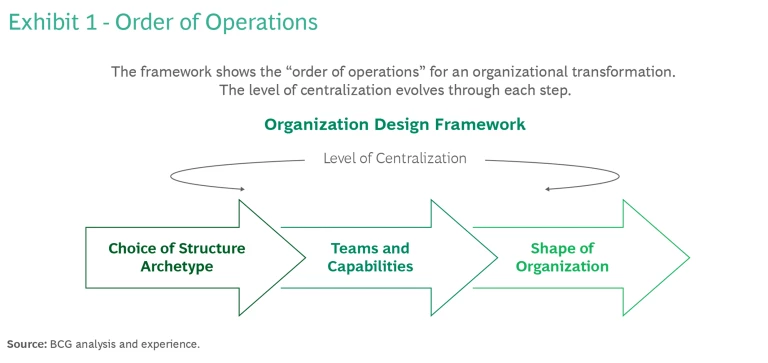
Structural archetypes. Five structural archetypes can serve as the organizing principle for marketing, each with its own advantages and disadvantages (See Exhibit 2). Choosing one approach usually means the company will have less expertise in the other areas.
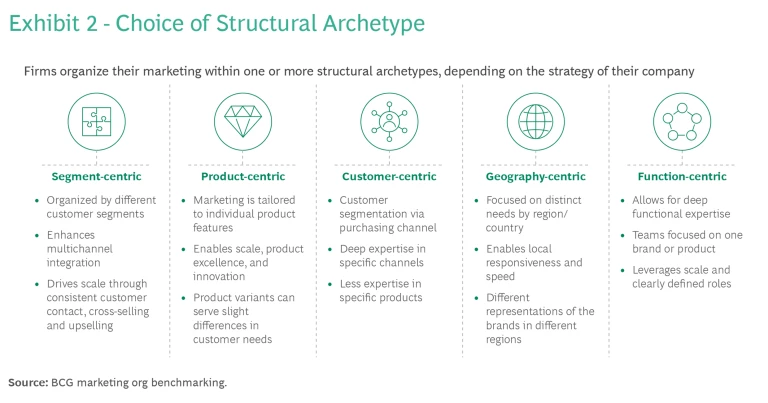
The most common archetype is function-centric, but only 35% of the companies we surveyed are using that approach. Most companies use a mix of archetypes. Large organizations are twice as likely to choose product as their organizing principle, despite power struggles between product leads and functional leads.
The transformation that one large consumer packaged goods company has undertaken shows how the level of centralization evolves as the structural archetype changes. Before the transformation, the company had a fully functional, expert-led model with all marketing responsibility ultimately rolling up to the CMO. To unlock stronger growth, the company decided to shift from that centralized, function-centric structure to a more decentralized, product-centric one. Marketing now reports within the brands, and the company has reallocated talent to the brands and in some cases hired from outside. Part of the original marketing function, meanwhile, survives as a center of excellence, with resources deployed dynamically if a brand requests support. The center of excellence also facilitates the exchange of ideas across brands.
The transformation created other advantages as well. The de-layering of the organization allows the company to make faster and less bureaucratic decisions. It also allows each brand to develop its own learning plan.
Marketing organizations now comprise a broader range of teams and capabilities.
Whereteams and capabilities sit. Marketing organizations now comprise a broader range of teams and capabilities. (See Exhibit 3.) The decision on where a function sits comes down to three factors: how large a team is, how closely it works with the core marketing function, and how incentives are aligned.
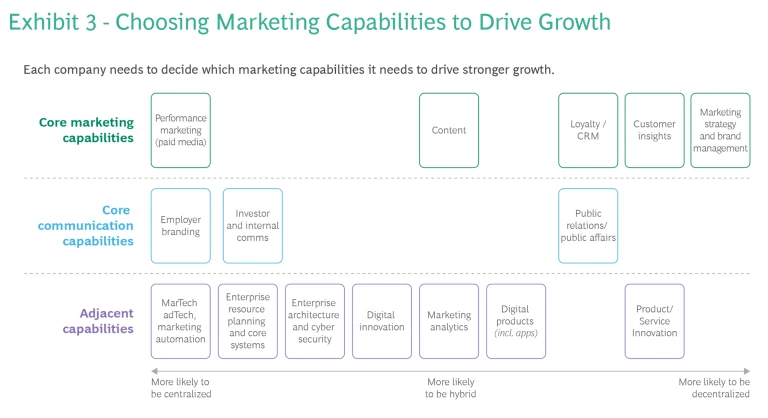
Customer insights, for example, is a core marketing capability of any modern marketing organization, because it influences positioning strategy, content, and other areas. But historically it has reported outside the marketing organization. Some 47% of organizations said that their analytics and insights roles are either partially or fully outside of marketing.
Our study also showed that some functions could either sit within marketing or in the IT/tech department. Only 50% of marketing organizations have ownership of marketing technology (martech), analytics, or e-commerce. Such organizations tend to be leaders in their markets, because they have concentrated more digital and analytical capabilities directly under marketing.
Shape of the organization. The shape of the organization reflects the number of functions and layers in the organization and the number of full-time employees (FTEs) in each area. It takes three factors into account.
First, the shape and the FTE allocation must align with the marketing goals and overall business strategy, taking workload, expertise, and scalability into account. Second, the organization needs to evaluate the workload required for marketing activities and determine the specific roles and responsibilities within the function, accounting for skill sets, specialization, and collaboration needs. Finally, the organization needs to balance efficiency and budget. It needs to aim for the right number of FTEs to meet workload demands without excessive stress or financial strain.
The level of centralization evolves during the transformation.
Thelevel of centralization evolves as the organization goes through each of these steps. Only 27% of the companies in our survey have a fully centralized structure, with smaller companies (revenue of less than $1 billion) more likely to choose centralization. In contrast, only 1% of companies are fully decentralized. The remaining companies have adopted hybrid structures which spread decision-making and execution capabilities across a broader range of roles while keeping some decisions centralized.
Find the Right Talent Internally and with Partners
Once the new structure of the marketing organization is in place, the next challenge is to find the right talent to fill the roles. To retain the right in-house talent, the company needs to provide the right opportunities for personal and professional development. As martech and internal processes change rapidly, organizations that invest in the digital capabilities of their current employees will hold a competitive edge. Such upskilling centers the organization around continuous learning.
But in many cases, it makes sense for an organization to outsource certain capabilities, such as digital-dominant roles. Digital now accounts for 65% of total spend and continues to grow its share, yet only 25% of FTEs in marketing organizations are digital specialists. This discrepancy highlights the need for more specialized digital talent than ever before.
Meeting the organization’s needs may therefore require both internal and external talent. Companies need to think strategically about to how to find the right balance so that they can keep objectives and key results (OKRs) aligned across the organization. Understanding insourcing and outsourcing trends helps the company decide how to use external partners strategically. The expertise of external partners may be helpful, for example, when volume is more important than speed.
We have observed that the use of in-house teams has increased year after year, rising to 78% in 2018 from 42% in 2008. The most popular functions to have in-house—in over 70% of companies—are analytics, brand strategy, organic/earned media, customer relationship management and email, and website and e-commerce. Exhibit 4 offers guidance on whether to bring certain functions in-house or work with external partners, but this trend towards insourcing shows a desire to move faster with more control.
Despite the overarching trend toward in-house, larger companies (those with revenues over $10 billion) outsource capabilities and maintain external partnerships to achieve scale. Large companies are 25% more likely than small companies to outsource, with paid media, creative, and martech currently the most outsourced functions.
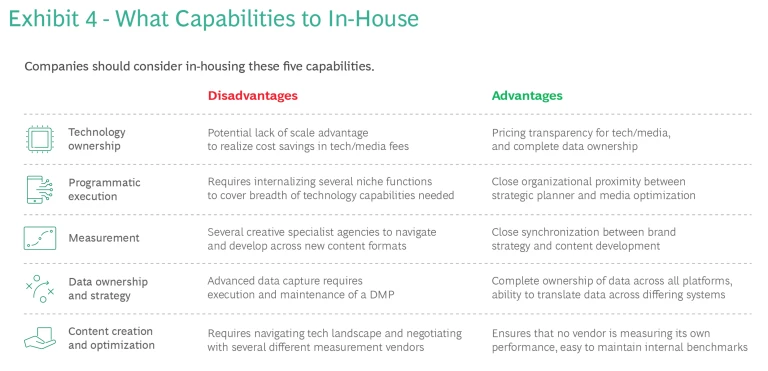
There is also a growing desire to outsource creative. Some 60% of companies in our study currently perform the work in-house, but 27% want to outsource it. One motivation for outsourcing creative is that it requires specialized scarce talent that is hard to recruit and retain. Some creative activities, such as television ads, are seasonal or sporadic rather than continuous, which would mean that in-house talent risks sitting idle. Despite early successful experiments, it remains unclear how tools such as generative AI will affect this trend by creating opportunities for companies to insource creative once again.
One US grocer outsourced all major creative, and now uses in-house creative primarily for quick digital needs or to adapt creative to fit sub-grocery brands. This has allowed them to scale and to deal better with capacity constraints that would otherwise slow down time-to-market.
Exhibit 5 shows the three approaches that companies deploy when working with agencies or other third parties. The most common approach is best of breed, under which companies work with multiple agencies based on their specializations or geographic presence. One agency plays a more prominent role in the other approaches, with the extreme being the use of a single agency under a centralized operating model.
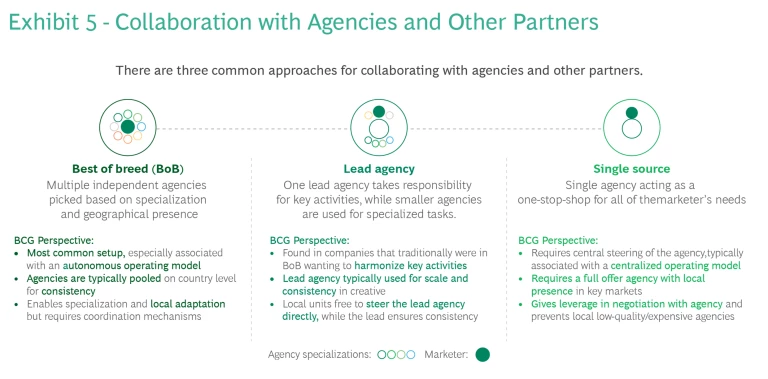
When choosing external partners, it is important to set the right incentive structure and collaboration model to ensure accountability, efficiency, and effectiveness. Compensation models can include commissions, retainers, pay-for performance, or a combination of different models. Around 60% of companies use service, project-based, or retainer structures, but performance-based fee structures are less popular for agencies. Some are willing to put part of their fees at risk under such a structure, but all parties need to recognize the added executional complexity. It is often hard, for example, to align on who will measure performance and what metrics they will use.
Operate as a Well-Oiled Agile Organization
The right organization structure and the optimal selection of talent are essential but not sufficient to enhance flexibility and improve marketing performance. The company also needs to figure out the right operating model. We have observed that a well-oiled marketing organization layers in agile ways of working to achieve greater flexibility, better resource management, and enhanced knowledge sharing.
Some 85% of marketing organizations in our survey have adopted some agile ways of working to increase speed to market, improve cost efficiency, and keep OKRs and incentives aligned. In detail, 27% of marketing organizations have adopted a fully agile model. But companies don’t have to go fully agile all at once. They can also implement agile in select initiatives, which means that only parts of organization—typically where initiatives have the highest pain points—implement first. Some 58% of companies are taking that route (See Exhibit 6)
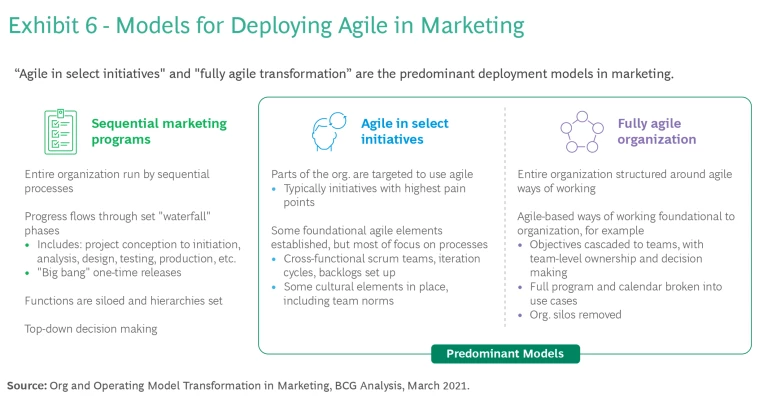
One benefit of agile is that it pools capabilities better, with fully integrated perspectives across different types of campaigns. The more flexible allocation of talent allows companies to bring the best team together for any campaign, which in turn results in much leaner teams for less time-critical campaigns. One company which has adopted agile principles has reduced the amount of time needed to launch a campaign by as much as 60%.
Exhibit 7 shows the four steps that help embed agile ways of working into the organization. It is a constant process of testing, learning, and adaptation.
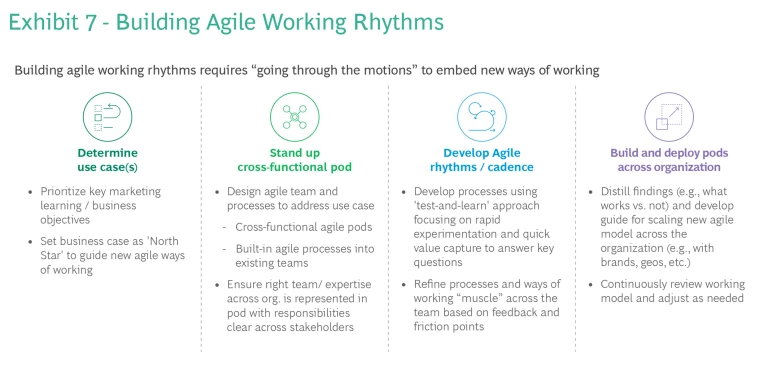
Challenges can arise, however, in hybrid organizations that have some functions that use agile and others which use it to a lesser extent or not at all. The two groups of functions can end up with different speeds of execution as well as a clash in expectations, priorities, and objectives. Teams also tend to become more siloed as company size increases. This leads to poor communication, slower execution, and breakdowns in strategic coordination.
Heightened urgency for companies to respond to the changing environment by rethinking and redesigning their marketing organizations.
Going into 2024, the trends we see and hear from marketing leaders show no signs of abating. This heightens the urgency for companies to respond to this changing environment by rethinking and redesigning their marketing organizations around these five areas.
- Strategy drives structure: Organizational choices should be in the service of strategy and objectives. Different design choices will emerge for organizations with different “north stars.”
- Balance capabilities: Building in-house digital capabilities will help companies future-proof their marketing organizations and ensure greater agility, control, and expertise.
- Use agile and other new ways of working: To keep up with ever-changing consumer and customer needs, a constantly evolving marketing ecosystem, and a dynamic business environment, it is vital for companies to redesign processes and governance so that they can respond quickly to market signals
- Focus on training and development: As digital capabilities (e.g,. GenAI) continue to evolve, organizations will need to plan for ongoing upskilling and capability building to keep pace with change.
- Monitor progress and adjust: Measuring progress and success is essential to understanding what’s working, what’s not, and why, so that the company can adjust course during the transformation journey
Successful transformations of marketing organizations follow these principles, start from the top down, and require coordination across the entire organization as well as with third parties.






